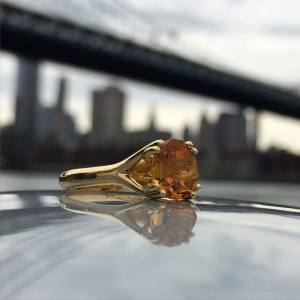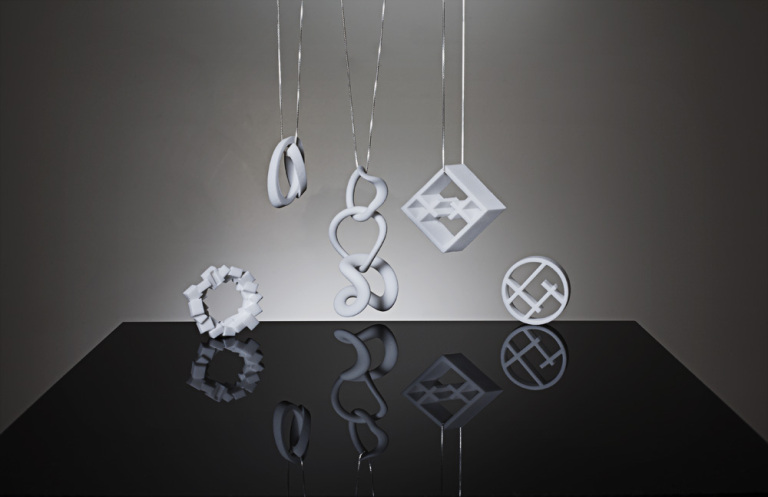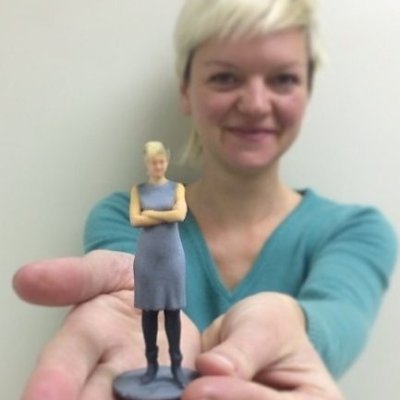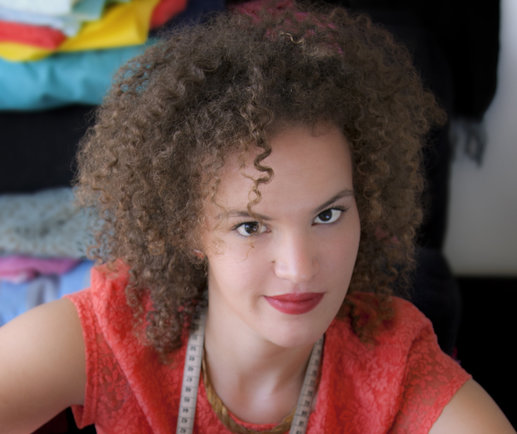This article originates from Women In 3D Printing and is part of our effort to support the use of 3D printing technology by women. The article is re-published with permission.
Natalia is an accomplished designer who discovered her passion for jewelry creation only after first leading herself to neuroscience studies.
Her particular background in Sciences probably led to her love for technology. As a Maker, 3D printing became a natural response to the technical challenges she faced when creating her pieces. Her jewelry seeks to combine the languages of science and art.
WI3DP: Natalia, could you let us know about your background and what brought you into 3D printing?
Natalia: I studied marketing and neuroscience initially, but throughout that degree I was selling simple beaded jewelry at craft markets on weekends. One day the girl next to me was selling silver rings and I asked her how she had taught herself to do that. She replied that she had done a goldsmithing degree. Not knowing that you could go to school for jewelry, I pretty much signed up right away. Which led me to do another undergraduate, this time a Bachelor of Gold and Silversmithing at RMIT. In our third year, we were encouraged to develop our own collection and I was drawn to really precise, geometric shapes. No matter how hard I tried, or how thin a steel I used (easier to be precise in thin metal), if my cuts or folds were even one millimeter off, your eye could see the irregularity and the effect was ruined. Frustrated, I thought “there MUST be a way I can use a computer to do this”…and so in 2008 I discovered CAD, specifically Rhino. I taught myself how to use it and within five minutes had made the shape I had been unsuccessful in making by hand for days. Talk about a turning point!
The architecture school had access to 3D printers but we were not allowed to use them. Luckily, at this time my dad sent me a link to check out this beta site called Shapeways. I still remember that package arriving with little plastic prints in it. I used them to make a mold, cast the wax in silver…and never looked back!
After graduating, I moved to New York seeking fame and fortune with a collection of 3D printed cufflinks for investment bankers. I had a really promising start with a collection to be sold at Bergdorf Goodman, and then Lehman Brothers collapsed, and well, you know what that did to the luxury market. So I focused on making small, colorful 3D printed earrings and a production line.
My friend encouraged me to sell my wares at MakerFaire. I put my stand in the (then new) 3DPrinter Village, and sent so many people to Shapeways booth that eventually Shapeways came to me and said “Who are you?!”. I offered to be their ambassador, and teach 3D modeling classes through Skillshare. Instead, I got hired to be the Shapeways Community Manager. Over the next three years, I did just that! It was amazing to be able to bring all my suggestions as a shop owner and use that to channel change. We didn’t build it all, but being a user really helped to understand our community. I hope I did a good job of representing the community’s interests!
I was certainly able to be involved in some awesome projects – 3D printing as a way to disrupt intellectual property, 3D printing in fashion, 3D printing in space – and be part of the growing interest and excitement around 3D printing.
WI3DP: Why using 3D printing? Do you combine 3D printing with other technologies and /or hand craft?
Natalia: Of course! I have my jewelry studio too so I am able to combine hand craft techniques as well as 3D printing. I’ve also used laser cutting in the past to make production pieces.
My work is a combination of art and science, and my inspiration is negative space. I love the freedom that 3D printing brings to my design work. When making jewelry by hand, you are limited by what you can do, and by existing manufacturing methods. More than once I have made a tool just to do a task, like a curved engraver to reach the inside of a ring. With 3D printing, that step is superfluous. You can design whatever you want! (ok there are still limitations, but having the inside view of the whole process of 3D printing, breakout and shipping I know how to design for the manufacturing process too). That said, there is no penalty for complexity.
I’m intrigued by the algorithms that are being written for generative design. Nervous System first introduced me to grasshopper scripts, and Nancy Liang to the idea of customizing base patterns to let consumers make creative decisions. What Kegan has done with SOLS – using internal structures to vary density within a shoe insole is a perfect use of 3D printing. You really can’t do it another way. Today Francis Bitonti and Bradley Rothenberg are developing not just design, but the blueprint for design, which is pretty exciting.
The fact we have a new tool in our toolbox is what is incredible. It’s also pretty cheap to try things out. And that’s exciting. I printed a “failed” design just to see it and it’s still my best-selling pair of earrings. I would never have made it by hand, the time investment would have been too much.
WI3DP: What do you think of the 3D printing industry today?
Natalia: I think it has a lot of untapped potential. There’s been talk of the consumer side being overblown, and I have to say, the hype has been real. We’re pretty demanding as a population. If you tell someone “3D printing means you can make anything” they are going to take you at your word. You need to then keep disappointing them “..as long as it’s in one material, and not too thin, and it’s going to be expensive”. Perhaps we should have set more realistic expectations like Henry Ford did with “any color as long as it’s black”…well that progressed and so will this. I said a long time ago that I don’t think there will be a 3D printer in every home, but there will be a 3D printed item..and I stand by that, because not everyone WANTS to make their own thing. Yes there is a growing, and fantastic, maker movement and 3D printing is an amazing resource to have at makerspaces and fab labs. But designers are the ones who are really taking advantage of it. I love being able to give a jewelry client a mockup in plastic that cost me $4 to print – it means I can communicate my idea more succinctly than a drawing. Even faster is sending them a Sketchfab link to the 3D model, that they can spin, zoom, and rotate and really interact what they are going to get.
Certainly industry is under-using 3D printing, but that’s a whole another story. What will happen to shipping when we are all able to print-on-demand at our location? What will happen to manufacturing when the cost of 3D printing drops 10x? A lot!
WI3DP: What would be your “dreams come true” in the industry?
Natalia: It needs to get easier, and it will. On the consumer side, we need to pay more attention to designers and what they are doing. They are the litmus test of what is needed. I think what Autodesk is doing with its Artist in Residence program at Pier 9 is the right idea – give the tools to artists and tinkers and dreamers and see what they do with it. Your best feedback is always going to be your users.
WI3DP: In your opinion, how could we encourage more women to become involved with 3D printing?
Natalia: Expose them to more role models. Goldieblox is doing wonders with getting little girls into engineering…and just exposing girls (and boys) that a possibility exists is enough. It can’t just be about making your own jewelry because, even as a jeweler, it’s too obvious. You can put a shell on a piece of string and you’ve make jewelry, you don’t need a 3D printer for that. But a ring that grows around the pretty shell you found? A rocketship for barbie? Yeah, fire up the Ulitmaker, let’s do it! Just knowing you can make anything is exciting.
I think Lauren Slowik is doing a lot for 3D printing education, her role at Shapeways lets her participate in events like MakerFaire and run Eyebeam mastnat (1)erclasses in computational fashion.
Mary Huang as a designer, Ashley Zelinskie and Sophie Kahn are artists using 3D printing in inventive ways. Annelie Koller is doing bio 3D printing with biopolymers. Carla Diana and Ebony Fleur also make up the ‘Lady Tech Guild’. Two women in the industry I admire as well are Justine Trubey who runs operations at Shapeways and Nikki Finemore doing community at 3DHubs. This website (womenin3d) is also fantastic!
Sketchfab is the easiest way to publish your 3D files. Naturally, some of our user base is sharing 3D printable models, and we offer the ability to download, so artists who want to share their work can easily do that and print them at home or using a service like 3DHubs, Shapeways, Sculpteo or iMaterialise.
I think the real value is far more than just 3D printing – we have game designers, graphic artists, architect, scientists (imagine being able to see a 3D animated bacteriophage do its work, well you can) and museums and cultural institutions uploading and sharing their cultural artifacts.
All the models on our site are VR ready. For me, it’s fun to once again be at the cutting edge of technology and see where it’s heading, while steering it from the inside. It’s like surfing really, if you catch the wave at the right time, you can control where you go.
Ironically by moving out of working directly in 3D printing, I’m using it more myself! Right now the absolute best use for it is for custom engagement rings. People love being able to design their special ring and the fact that it’s 3D printed only adds to the appeal. There is still a certain thrill in being able to say “My ring was 3D printed! How cool is that?”.
If you are interested in learning more about Natalia and her work, we invite you to visit her shop here!
And don’t forget to join the Women in 3D Printing group on LinkedIn and Facebook!
California-based Nora Toure is the woman behind “Women in 3D Printing”, a group dedicated to promoting and showcasing the use of 3D printing for women. She’s also a Sales Manager at 3D print -on-demand service Sculpteo.







